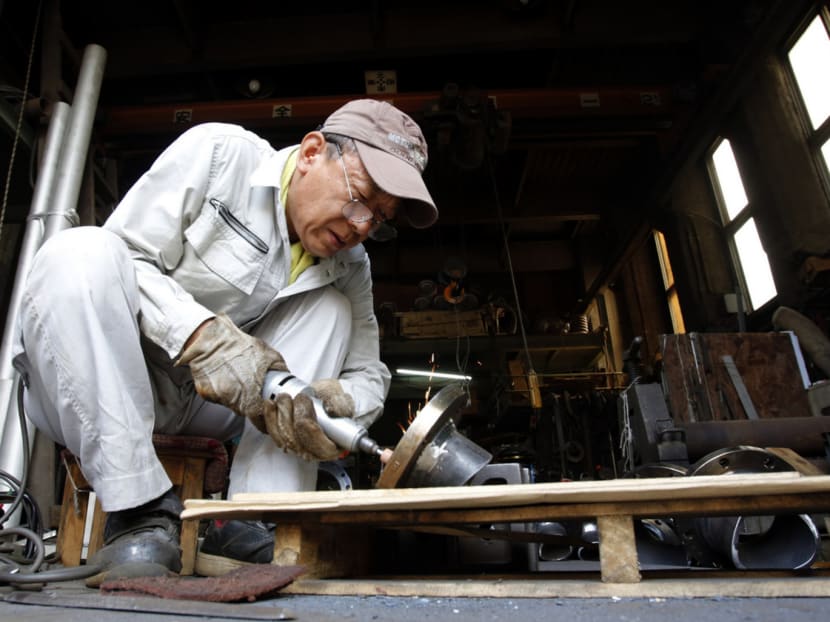Japan ahead of the curve in hiring seniors
TOKYO — Japan is ahead of the global curve when it comes to ageing. Last year, nearly 27 per cent of the population was aged 65 or older, making it one of the greyest countries in the world and heightening concerns about an increasingly strained labour force.

With nearly 27 per cent of Japan’s population aged 65 or older, seniority is being appreciated with workers encouraged to stay on and impart their skills and experience to a younger workforce. PHOTO: REUTERS
TOKYO — Japan is ahead of the global curve when it comes to ageing. Last year, nearly 27 per cent of the population was aged 65 or older, making it one of the greyest countries in the world and heightening concerns about an increasingly strained labour force.
But Japan is also ahead of the curve when it comes to putting seniors to work. As more employers are discovering, all that silver is a valuable resource that can be spun into business gold.
One company that understands this well is cosmetics maker Pola, whose sales force includes a woman who recently turned 100. In June, sales staff gathered at a Pola shop in Tokyo’s Setagaya Ward to learn about the company’s latest products and its promotional campaigns.
“How is this cream different from the current one? When should our customers apply the product to get the best results — during the day or at night?” The shop’s owner, Ms Miyoko Sugiyama, 83, peppered the representative from Pola headquarters with questions. “Unless I know the products well and can explain them in an easy-to-understand way, I will fail to fulfil my responsibility and my clients won’t trust me,” she said.
Retailers talk a lot about customer databases. Ms Sugiyama’s is in her head. She knows the preferences, ages, health status and shopping habits of her 30-odd clients. When new products come out or her clients are about to use something for the first time, she visits them by bicycle or train. The octogenarian’s energy is astounding.
Nationwide, Pola has about 50,000 “beauty directors” like Ms Sugiyama. They are independent business owners who sign consignment contracts and visit customers’ homes. They form close, long-term relationships with homemakers, who are among the company’s main customers.
When Pola began recruiting saleswomen in 1937, applications came flooding in. In those days, Japanese women had few opportunities to work outside the home. The company says there is no retirement age; its sales representatives can work as long as they want. Among its 50,000 beauty directors are some 5,500 people in their 70s, 2,500 in their 80s and 250 in their 90s.
Ms Sugiyama began working for Pola more than four decades ago. She took up the work out of curiosity, she said, but quickly made her mark, becoming head saleswoman at a shop in three years.
Now, she leads a team of sales representatives and posts monthly sales of ¥2.3 million (S$30,600). In her career, she has sold around ¥180 million worth of Pola cosmetics.
Some beauty directors go on to become “grand owners” in charge of two or more shops. Ms Sayaka Honjo, 76, oversees more than 90 shops, racking up average monthly sales of ¥150 million. Ms Honjo, who has five grandchildren, is Pola’s top sales representative.
Some 95 per cent of the ¥100 billion that Pola products bring in each year comes from beauty directors like Ms Sugiyama. Finding regular customers is crucial for cosmetics makers, so the strong client networks built by Pola’s sales reps are a huge asset. “I won’t retire as long as my clients want me,” said Ms Sugiyama.
Manufacturing drove Japan’s postwar economic boom and remains a pillar of the country’s stability. For manufacturers, survival means passing the skills of experienced workers on to younger hands.
Bearing maker Isoda Metal, founded in 1905, is adapting itself to Japan’s ageing society. About a decade ago, the Tokyo-based company began allowing skilled workers to stay on past the retirement age of 65.
Mr Kenji Seto, 71, is taking advantage of the new rules. He has been at Isoda for 34 years. On the day the Nikkei Asian Review met him, he was grinding bearings, measuring them with a micrometer. The process, which he said requires accuracy to within 100th of a millimetre, takes years of experience and intuition to learn. Mr Seto is on his feet for hours, concentrating intently. But he has developed a rhythm and never considered his job tough, he said.
The skilled technician is also an instructor, advising colleagues in their 20s and 30s who eagerly seek his help. “I want to pass on to them every technique I’ve mastered,” Mr Seto said.
Today, Isoda supplies parts for ships and other watercraft, including Japan’s Self Defence Force submarines and coast guard patrol vessels. For the 111-year-old company, maintaining the quality of its craft is a top priority. Mr Daisuke Hattori, Isoda’s president, said the company began offering post-retirement employment because letting skilled mechanics go was a business risk.
“Many experienced mechanics in the past thought younger workers should learn by watching their seniors, rather than being taught. Now we are asking veteran workers to share their techniques,” said Mr Hattori.
The company signs one-year contracts with workers who are aged 65 or older. Now employees in their 60s to 80s make up a quarter of the workforce. Many of them double as instructors to junior workers.
Kato Mfg, a sheet metal manufacturer based in the central Japanese city of Nakatsugawa, offers another example. In 2001, the company introduced the unusual recruiting practice of hiring only people aged 60 or older. Elderly part-time employees work on weekends and holidays, allowing the company to run its production line 24/7 and streamline its operations.
Kato supplies components for Boeing’s 787 jetliner and main wing parts for Japan’s first homegrown jet, Mitsubishi’s MRJ. Many members of the team in charge of producing these components are in their 60s. FINANCIAL TIMES






